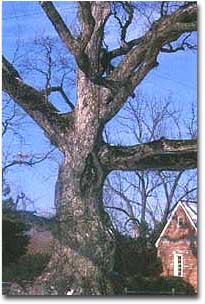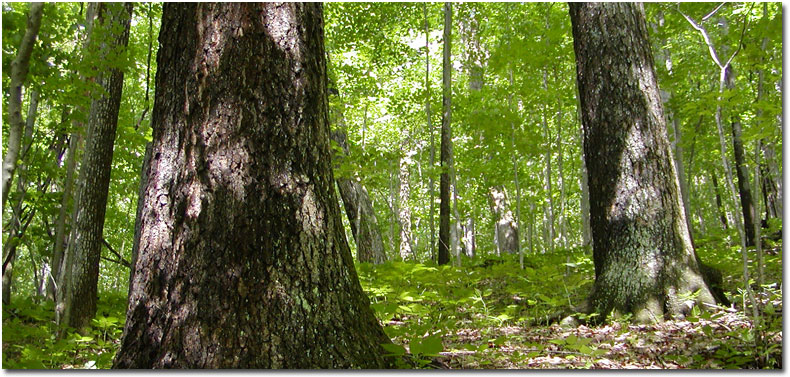 Maryland's Wye Oak was long recognized as the largest white oak tree in the nation. Its stately presence in the village of Wye Mills in Talbot County had marked the passage of time for many generations. Since beginning its quiet unassuming life in the 1500s, it had seen the fall of a civilization and the birth of a nation. Native Americans, believed to be the Wiccomisses, lived and hunted in the area. The Choptank Trail, which ran down the east side of the Chesapeake Bay, traversing the land from the head of one river to the next, was near the oak. This ancient trail later developed into a road and as the tree grew, its boughs provided shade for the early settlers as they traveled by. The road, which eventually linked Oxford with Philadelphia, became an important cog in the settlement of the Eastern Shore.
Maryland's Wye Oak was long recognized as the largest white oak tree in the nation. Its stately presence in the village of Wye Mills in Talbot County had marked the passage of time for many generations. Since beginning its quiet unassuming life in the 1500s, it had seen the fall of a civilization and the birth of a nation. Native Americans, believed to be the Wiccomisses, lived and hunted in the area. The Choptank Trail, which ran down the east side of the Chesapeake Bay, traversing the land from the head of one river to the next, was near the oak. This ancient trail later developed into a road and as the tree grew, its boughs provided shade for the early settlers as they traveled by. The road, which eventually linked Oxford with Philadelphia, became an important cog in the settlement of the Eastern Shore.
Throughout its life, the Wye Oak was the property of a number of owners. Before the tree grew into prominence, it was part of a tract of land called Wilton, which was patented in 1665 by Thomas Willams. Richard Bennett purchased Wilton in 1705, and it remained in his family until 1797, when the estate was sold and the land along Wye Mills Road was divided into lots. The Wye Oak was on a 2 1/2 acre parcel purchased by Johannes Arants.
The tree continued to mature into its majesty. While it was the property of Dr. Syndenham T. Russum, from 1831 to 1867, people began to recognize it, referring to it as the Russum Oak. It was not until the early 1900’s that the tree was called the Wye Oak, after the village of Wye Mills.
In 1909, the then gigantic tree was first officially distinguished for its size. Maryland’s first State Forester, Fred Besley, along with C. Howard Lloyd, himself a descendant of Richard Bennett, measured and photographed the tree. Many people began to consider it the largest white oak in the state and, for the first time, visitors came to view its sweeping boughs. Ten years later, the American Forestry Magazine honored the Wye in its Tree Hall of Fame and launched what would later become a national search for Big Tree Champions. The Wye Oak held the title of largest white oak in the United States since the American Forestry Association began its contest in 1940.
In 1939, the State of Maryland purchased the Wye Oak from its last private owner, “in accordance with our desire to preserve places of historical and outstanding interest,” said Governor O’Connor. Soon after this purchase the Legislature declared the Wye Oak to be the living symbol of our State Tree, the white oak.
Among the impressive characteristics of the Wye were its massive “knees” or buttresses, which helped support the huge tree. The actual cause of this unusual formation was a matter of some speculation. One explanation offered was that an old country store was once located at the site of the tree, and the stomping hooves of the customers’ horses, tethered to the tree bruised the roots, resulting in a malformation which eventually developed into large burls.
Windfall was seen as the single, most important threat to its life, as evidenced by the scars on the tree by the sudden loss of some of its large limbs in the past century. The first limb fell in October 1953 during a thunderstorm. A second limb fell in August 1955 after a hurricane loosened the cables earlier in the summer. A third limb fell in June 1984. From this limb, a lasting legacy of the tree was carved in the form of a statue of two children planting a tree.
Over the years, the tree was well tended. Fencing was installed to keep the many visitors from walking on the fine roots near the soil surface. Yards and yards of cabling were installed to support the massive crown. The tree crown was thinned and the deadwood removed periodically. Its massive hollow bole was sealed to protect against vandalism and further deterioration. The tree became more than just a living symbol of the state tree. It stood to represent time passed and time to come, the generations of people it witnessed in life, and the perseverance of man and nature. The desire to have this tree live on led to its offspring being grown at the state nursery whenever the Wye produced acorns. Thousands of Wye Oak offspring have been planted not only across Maryland but around the United States.
As it was a gift of nature, nature determined the big tree’s course. On June 6, 2002 the mighty Wye Oak succumbed to time and the elements as its massive trunk collapsed during a severe thunderstorm, ending the life of Maryland’s oldest citizen. At its end, the tree measured 31 feet 8 inches in circumference, was 96 feet tall and had an average crown spread of 119 feet. The main bole of the tree weighed over 61,000 pounds.
This famous tree lived in the Wye Oak State Park and was truly a part of the history of Maryland. Man had done all he could to extend the life of this venerable monarch. A tree is a child of the earth and to the earth we knew it would inevitably fall. Happily, the legacy of the Wye Oak lives on, as its offspring now produce acorns and the next generation of the Wye Oak.

